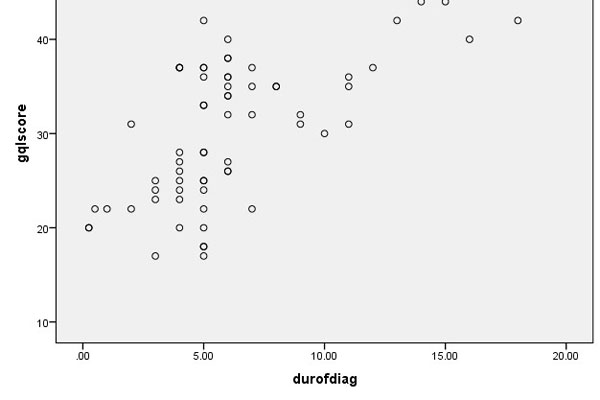Assessment of quality of life in glaucoma patients using the Glaucoma Quality of Life-15 questionnaire
Abstract
Purpose: The purpose of this study was to assess quality of life in glaucoma patients using the Glaucoma Quality of Life-15 (GQL-15) questionnaire. The GQL-15 questionnaire is a glaucoma-specific quality of life questionnaire used to assess the degree of functional disability caused by glaucoma.
Design: Cross-sectional, prospective study with comparison group at a tertiary care hospital.
Materials and methods: The GQL-15 questionnaire was used to evaluate the quality of 80 patients in the glaucoma group and 80 normal subjects in the control group. The data were analyzed by test of proportions and Chi-square test. A p-value of < 0.05 was considered significant.
Results: Glaucoma patients (mean age: 60.5 ± 9.2 years; range: 43–86 years) and comparison group (mean age: 58.9 ± 4.5 years; 52–72 years) were matched with respect to age (p = 0.18). Glaucoma patients had significantly worse quality of life compared to the non-glaucoma group (p < 0.001). Significant differences (p < 0.05) between the scores of the mild, moderate, and severe glaucoma groups were observed, suggesting poorer quality of life as the severity of glaucoma increases.
Conclusions: The GQL-15 revealed that quality of life worsens with increasing severity of glaucoma increases. This fact is important when educating patients about the disease course and its therapy.
References
Glen FC, Crabb DP, Garway-Heath DF. The direction of research into visual disability and quality of life in glaucoma. BMC Ophthalmol. 2011;11(1):19.
Nelson P, Aspinall P, Papasouliotis O, Worton B, O’Brien C. Quality of life in glaucoma and its relationship with visual function. J Glaucoma. 2003;12:139–150.
Heijl A, Traverso CE, editors. European Glaucoma Society Terminology and Guidelines for Glaucoma, 3rd ed. Italy; European Glaucoma Society: 2008. p. 119-120.
Iester M, Zingirian M. Quality of life in patients with early, moderate and advanced glaucoma. Eye. 2002;16(1):44-49.
Mills RP, Janz NK, Wren PA, et al. Correlation of visual field with quality-of-life measures of diagnosis in the Collaborative Initial Glaucoma Treatment study (CIGTS). J Glaucoma. 2001;10(3):192-198.
Ramulu P. Glaucoma and disability: Which tasks are affected and at what stage of disease? Curr Opin Ophthalmol. 2009;20(2):92-98.
Janz NK, Wren PA, Lichter PR, Musch DC, Gillespie BW, Guire KE. Quality of life in newly diagnosed glaucoma patients: The Collaborative Initial Glaucoma Treatment Study. Ophthalmology 2001;108:887-97.
Onakoya AO, Mbadugha CA, Aribaba OT, Ibidapo OO. Quality of life of primary open angle glaucoma patients in Lagos, Nigeria: clinical and socio-demographic correlates. J Glaucoma. 2012;21(5):287-295.
Goldberg I, Clement CI, Chiang TH, John WG, Lauren JL, Suart G, Paul H. Assessing quality of life in patients with glaucoma using the Glaucoma Quality of Life-15 (GQL-15) Questionnaire. J Glaucoma. 2009;18:6–12.
Skalicky S, Goldberg I. Depression and quality of life in patients with glaucoma: a cross-sectional analysis using the Geriatric Depression Scale-15, assessment of function related to vision, and the Glaucoma Quality of Life-15. J Glaucoma. 2008;17:546–551.
Van Gestel A, Webers CA, Beckers HJ, et al. The relationship between visual field loss in glaucoma and health-related quality-of life. Eye. 2010;24:1759–1769.
Hirneiss C. Measurement of glaucoma-specific functionality with the GQL-15 and correlation with parameters of visual function. Ophthalmology. 2011;108(10):939-946.
Wang B, Aung T, Marella M, et al. Impact of bilateral open and closed-angle glaucoma on glaucoma-specific functioning in Asians. J Glaucoma. 2013;22(4):330-335.
Iester M, Zingirian M. Quality of life in patients with early, moderate and advanced glaucoma. Eye. 2002;16:44-49.
Arora V, Bali SJ, Gupta SK, Vashisht P, Agarwal T, Sreenivas V, Dada TI. Impact of initial topical medical therapy on short-term quality of life in newly diagnosed patients with primary glaucoma. Indian J Ophthalmol. 2015;63:511-515.
Emerick GT. Quality of life and glaucoma medications. Do our prescriptions make a difference? Glaucoma Today. 2005;5:38–39.
Robin AL, Covert D. Does adjunctive glaucoma therapy affect adherence to the initial primary therapy? Ophthalmology. 2005;112(5):863-868.
Nordmann JP, Auzanneau N, Ricard S, Berdeaux G. Vision related quality of life and topical glaucoma treatment side effects. Health and Quality of Life Outcomes. 2003;1:75.
Kumar S, Ichhpujani P, Singh R, Thakur S, Sharma M, Nagpal N. The impact of primary open-angle glaucoma: Quality of life in Indian patients. Indian J Ophthalmol. 2018;66(3):416-419.
Wang Y, Alnwisi S, Ke M. The impact of mild, moderate, and severe visual field loss in glaucoma on patients’ quality of life measured via the Glaucoma Quality of Life-15 Questionnaire: A meta-analysis. Medicine (Baltimore). 2017;96(48):e8019.
Varma R, Richman EA, Ferris FL, Bressler NM. Use of patient reported outcomes in medical product development: a report from the 2009 NEI/FDA Clinical Trial Endpoints Symposium. Invest Ophthalmol Vis Sci. 2010;51:6095–6103.
Khadka J, Pesudovs K, McAlinden C, Vogel M, Kernt M, Hirneiss C. Reengineering the glaucoma quality of life-15 questionnaire with Rasch analysis. Invest Ophthalmol Vis Sci. 2011;52(9):6971-6977.
Nelson P, Aspinall PA, O’Brien C. Patients’ perception of visual impairment in glaucoma: a pilot study. Br J Ophthalmol. 1999;83:546–552.

Copyright (c) 2020 Sulatha V. Bhandary, Pallak Kusumkar, Lavanya G. Rao, Surabhi Abbagani, Krishna Rao Addoor

This work is licensed under a Creative Commons Attribution 4.0 International License.
Authors who publish with this journal agree to the following terms:
- Authors retain copyright and grant the journal right of first publication, with the work twelve (12) months after publication simultaneously licensed under a Creative Commons Attribution License that allows others to share the work with an acknowledgement of the work's authorship and initial publication in this journal.
- Authors are able to enter into separate, additional contractual arrangements for the non-exclusive distribution of the journal's published version of the work (e.g., post it to an institutional repository or publish it in a book), with an acknowledgement of its initial publication in this journal.
- Authors are permitted and encouraged to post their work online (e.g., in institutional repositories or on their website) prior to and during the submission process, as it can lead to productive exchanges, as well as earlier and greater citation of published work (See The Effect of Open Access).


